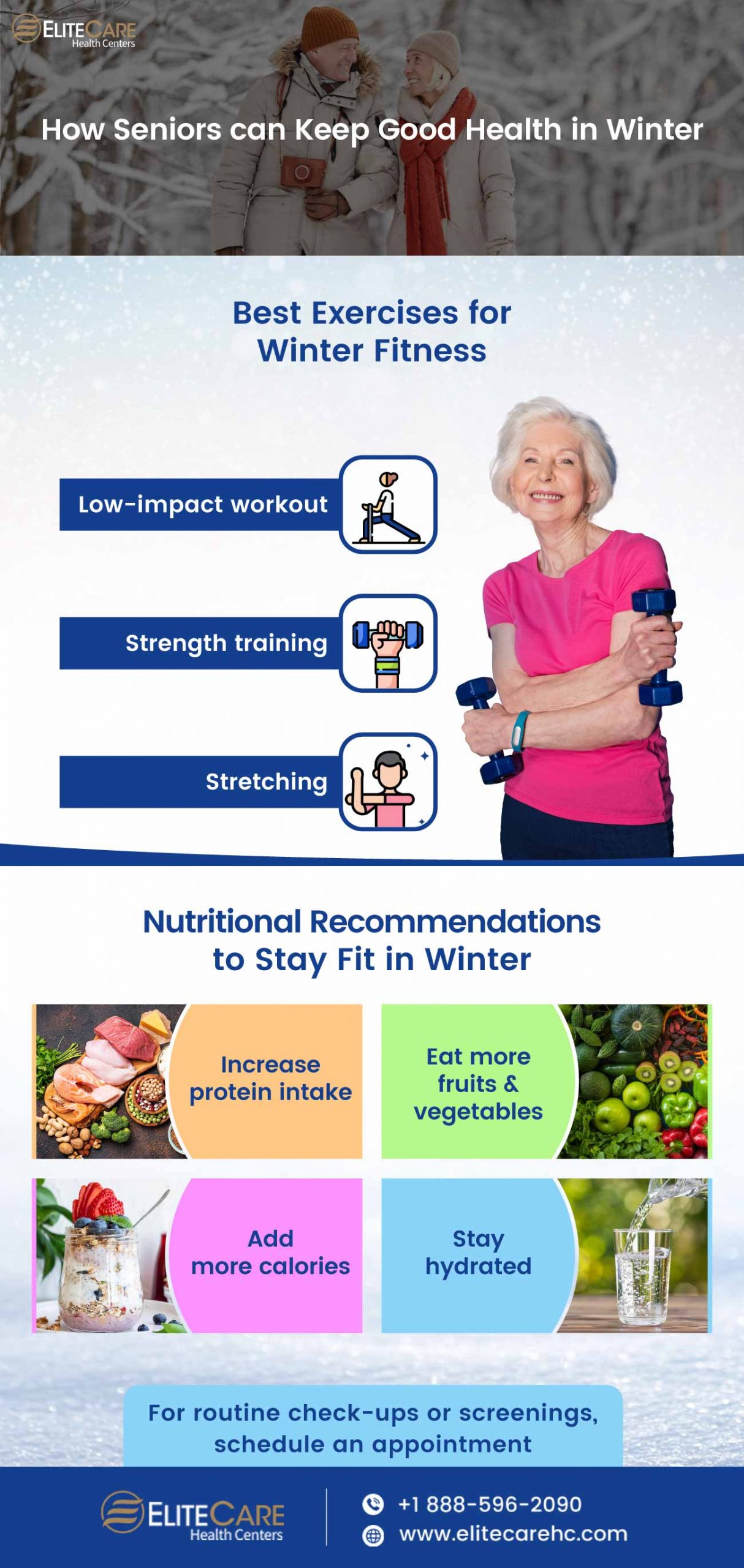
Staying fit and healthy during the winter months can be a challenge, especially for seniors who are more susceptible to health risks associated with the cold weather. The Centers for Disease Control and Prevention (CDC) reveals that an average of about 36,000 people* lose their lives each year from hypothermia. It is a condition in which the body loses heat faster than it can produce heat, therefore, lowering body temperature in an alarming rate.
However, with the right approach and a few exercise tips, seniors can maintain their physical fitness and overall well-being during the winter months. This blog will provide detailed information on how to be fit and healthy in winter. Let’s take a look!
How to Stay Warm During Winter?
Wear Layers
The idea behind layering is to trap air between the layers, which then helps in creating insulation and retains body heat. For example, start with a moisture-wicking base layer, add an insulating layer such as a fleece or down jacket, and finally, finish with a wind-resistant outer layer. In this way, it becomes easier to adjust the layers depending on the temperature.
Invest in Winter Gear
Keep a warm hat, gloves, and a scarf to cover the extremities, as well as waterproof and insulated boots ready to keep the feet dry and warm. Consider purchasing a good quality winter coat or parka specifically designed to maintain the core temperature.
Choose Appropriate Exercise Locations
It is crucial to choose appropriate locations for exercise during winter to avoid cold-related health problems. For instance, indoor activities such as swimming, yoga, or cardio at a gym are great options. For outdoor activities, choose locations that are sheltered from the wind and have adequate sunlight.
Best Exercises for Seniors to Stay Fit in Winter

1. Low Impact Exercises
These exercises are easy on the joints and improve cardiovascular health and overall fitness. Walking, cycling, and water aerobics are some of the best low-impact exercises for seniors.
For the starter, find a safe and well-lit indoor or outdoor location and start with a warm-up of 5-10 minutes of light activity, such as walking or marching in place. Then, perform 30 minutes of low impact exercise at a moderate pace, and end with a cool-down of 5-10 minutes of stretching.
2. Strength Training
It is an important component of a fitness program for seniors in winter, especially when the body may be more susceptible to risks related to injuries. Resistance bands, light weights, and bodyweight exercises are some of the most effective ways seniors can build strength.
Start with a light weight and gradually increase the resistance once the exercise feels comfortable. Set a goal to perform at least 2-3 sets of 8-12 repetitions of each exercise, with a rest period of 30-60 seconds between sets.
3. Stretching & Flexibility Exercises
In the winter months, stretching and flexibility exercises are crucial when the body may be stiff from spending more time indoors. Some of the best flexibility exercises for seniors include gentle yoga, tai chi, and stretching.
Start slowly and focus on proper form, gradually increasing the level of difficulty. Hold each position for 15-30 seconds and then repeat each stretch 2-3 times for the best results.
Nutritional Recommendations to Stay Fit in Winter

1. Increase Protein Intake
Protein helps to build and repair muscle tissue, which is especially required in colder, winter months. Some of the good sources of protein include chicken, fish, eggs, dairy, and legumes. Aim to include a source of protein in each meal, such as a serving of chicken breast with a salad, or a lentil curry.
2. Add More Calories
During the winter months, the body requires more calories to maintain energy levels and stay warm. By adding healthy sources of calories such as nuts, seeds, avocado, and whole grains to meals, seniors can add more calories to their diet.
In addition, warm and comforting winter foods like soups, stews, and casseroles can also help increase calorie intake.
3. Eat More Fruits and Vegetables
Fruits and vegetables are high in vitamins, minerals, and fiber, which can help boost the immune system and improve digestive health during winter. Aim to include a variety of colorful fruits and vegetables in your diet, such as leafy greens, carrots, apples, and berries.
4. Stay Hydrated
Staying hydrated is important for overall health and fitness, especially in the winter months. Aim to drink at least 8 cups of water per day and consider incorporating herbal teas or broths into your diet for added hydration.
Conclusion
Remember, it is never too late to start taking care of your health, and every small step you take toward fitness and wellness can make a big difference in the long run. For routine physical exams or any queries or concerns related to seniors’ health, visit your nearest EliteCare Health Centers office, or contact us to schedule an appointment with our primary care physicians.






